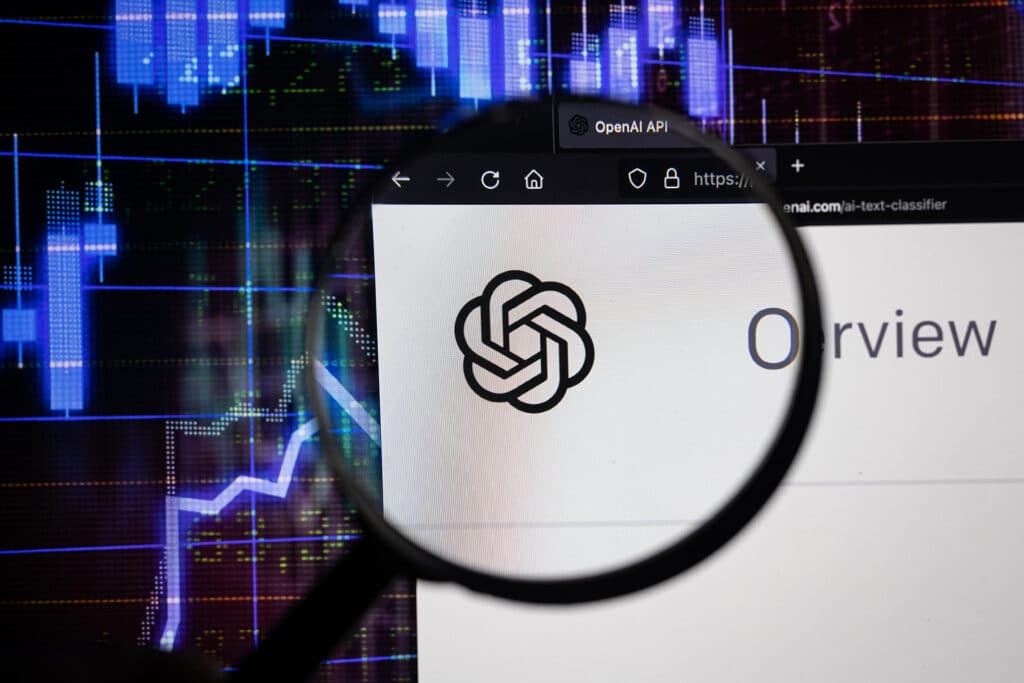What is ChatGPT?
ChatGPT is a chatbot based on artificial intelligence and sophisticated machine learning algorithms.
Its main goal is to provide users with an almost human-like and contextual experience by generating intelligent text responses. To do this, the language model draws on an extensive collection of text data from the Internet to provide high-quality responses.
ChatGPT’s uses are diverse, ranging from customer support chats to survey creation support. With its impressive conversational capability, ChatGPT is a valuable tool for virtual assistants and other applications.
However, it is important to note that ChatGPT also has its limitations. Occasionally, inaccurate or misleading responses may occur, as the bot is prone to bias or replaying biases from the training data.
Therefore, it is of great importance to critically review the results and include human review or post-processing if necessary.

Advantages and disadvantages of ChatGPT
ChatGPT, like any AI technology, has both advantages and disadvantages. Below, I’ll explain in more detail what they are.
Advantages:
- Natural language processing
ChatGPT can have human-like conversations and understand complex questions or queries. - Speed of response
The chatbot can respond to queries and provide information within a few seconds. - Context awareness
ChatGPT takes into account the context of a conversation and can thus provide relevant information or refer to previous questions or answers. - 24/7 Availability
Since the chatbot is available 24/7, users can get answers at any time. - Scalability
ChatGPT can be easily integrated on different platforms and systems, making it scalable for use in companies of different sizes. - Time and Cost
Savings Using ChatGPT enables efficient automation of tasks, resulting in time and cost savings. - Flexibility
It can be used in various use cases, for example, from customer support to data analytics.
Disadvantages:
- Limited comprehension ability
ChatGPT may have difficulty fully understanding and responding appropriately to complex or ambiguous requests. - Limited Knowledge/Potential Error Proneness
ChatGPT is based on available training data and therefore cannot go beyond what it has learned. When confronted with questions or topics that are outside its knowledge range, it may not be able to provide correct or appropriate responses. - Sensitivity to input formatting
The way a question is asked or the way information is presented can affect ChatGPT’s response. Sometimes it is sensitive to small changes in wording and may provide different or unexpected answers. - Lack of empathy
Because ChatGPT does not have real emotions, it may be difficult to appropriately recognize and respond to human needs or emotional nuances. - Ethics and bias
ChatGPT is trained using large amounts of text data that may contain bias or inappropriate content. This may result in ChatGPT unintentionally reflecting biases or making discriminatory statements.
It is important to consider these ethical issues when using ChatGPT and to take steps to minimize such issues.
Possible applications of ChatGPT in survey creation
As already mentioned, ChatGPT offers both advantages and disadvantages.
But how can ChatGPT be used specifically in survey creation and what are its limitations?
Theoretically, the possible uses are numerous: for example, the chatbot can help formulate questions and answers, create text for a welcome page, improve question wording, or even generate entire surveys.
So, in order to test the performance of ChatGPT in practice, I developed various use cases and actively implemented them with the chatbot.
The goal was to find out how well ChatGPT is able to meet specific survey generation requirements.
Below, I’ll introduce you to some of these use cases and present the results.
You’ll see which tasks the bot was able to successfully handle and where there might be room for improvement.
So let’s explore together how ChatGPT can be used in survey creation and what my experiences have been.
1st Use Case: Creating introductory text
In my first use case, I want to use AI to create an engaging introductory text for the welcome page of my survey on work-life balance.
To do this, I give ChatGPT the following instruction:
"Please create an introduction for my survey on work-life balance. I want my employees to answer the survey. The text should state what the survey is about, its purpose, and that the collection of data is anonymous."
Within seconds, ChatGPT suggests me a proposal for the introductory text of the welcome page.
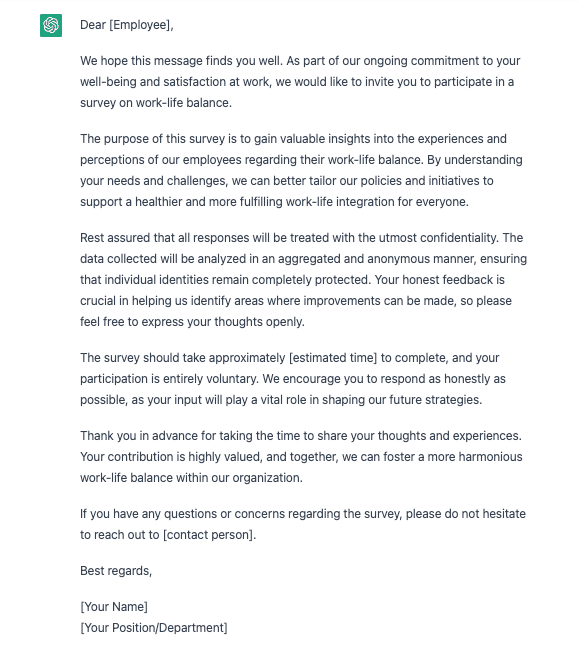
As you can see, ChatGPT has already created a very good suggestion for the welcome page with just a few pieces of information.
I can either take this text directly into my survey or add the final touches to customize it to my specific needs.
2nd use case: Generation of a question with answer options
My second use case involves generating a question with answer options for my survey on the topic of workplace stress.
To do this, I give the chatbot the following instruction:
"Please create a question for me with different answer options that fits the topic of workplace stress. I would like to know what workplace stresses employees are dealing with."
After I enter the command into ChatGPT’s console, the chatbot presents me with the following suggestion:
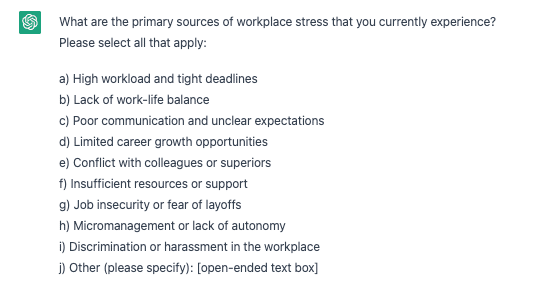
Again, I’m blown away by the question and the suggested answer options generated by the bot.
3rd use case: Optimization of a question
In this case, I ask ChatGPT to optimize an existing question for understandability.
The original question is “What shampoo do you use on your head?”
To do this, I ask ChatGPT the following question:
"Is the following question understandable to you? What shampoo do you use for the head?
If no, then please change it so that the question is understandable."
After I enter the command into the prompt (input screen) of ChatGPT, the chatbot presents me with the following suggestion:

The chatbot has optimized the question by replacing the word “head” with „hair” and asking for the type or brand. This makes the question more understandable and clearer.
4th Use Case: Creating a complete survey
After successfully running several smaller tests with ChatGPT, we would now like to tackle a more challenging task.
Our goal is to enable the bot to generate a complete survey on the topic of “employee satisfaction“.
To achieve this, we give the chatbot the following instruction: "Please create a survey for me to improve employee satisfaction in my company. The survey should include closed-ended as well as open-ended questions. Also, an NPS scale should be part of the survey as well as a welcome text and a closing text."
With amazing speed, ChatGPT then generates the following survey for us:
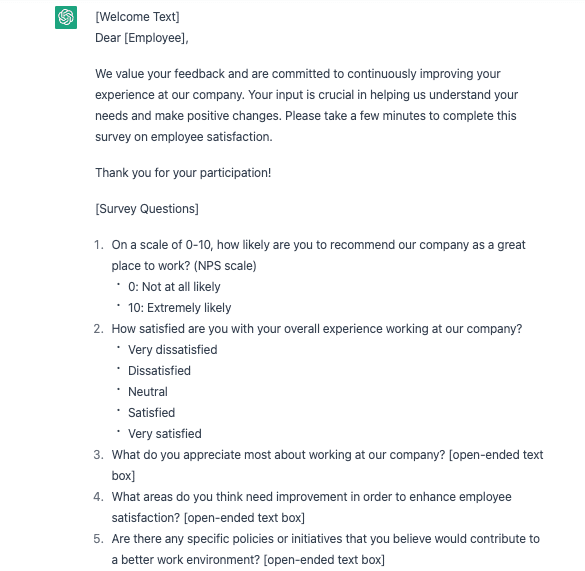
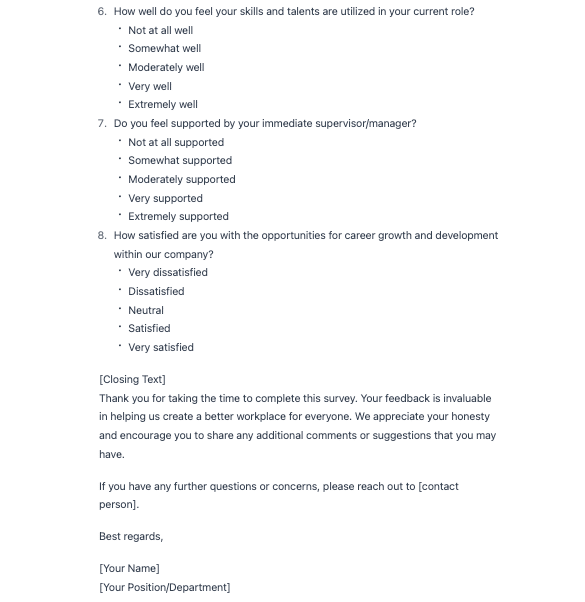
Best practices for using ChatGPT in survey creation
As we have already noted, OpenAI’s chatbot can be an extremely useful tool for survey creation.
However, when using it, there are some important points to keep in mind in order to achieve optimal results.
The most important aspect of interacting with ChatGPT is communication.
Formulate requests and instructions as precisely as possible to avoid misunderstandings. The clearer your question and instruction is, the better the chatbot can provide you with a suitable answer.
If ChatGPT’s answer does not meet your expectations or needs improvement, you can provide feedback to the AI and have it try again. Repeated feedback allows the chatbot to learn and get better results.
Patience is also an important virtue, as the desired results may not be achieved immediately. In such cases, experimentation is key. Try different approaches and ask different questions to get the full potential of the bot.
It is also important to keep in mind that although ChatGPT can deliver impressive answers, generated content should be viewed critically.
Always check the accuracy and relevance of the information received, especially when dealing with sensitive topics or legal issues. This is where critical thinking and human expertise come into play.
In addition, personal and confidential information should not be shared with the AI. Although the chatbot does not store data, it is advisable to avoid sharing sensitive information for security reasons.
To summarize, here are the best practices again:
1. Provide clear and concise instructions
2. Provide context
3. Provide iterative feedback
4. Incorporate human expertise
5. Avoid sharing confidential information
6. Experiment and explore
7. Be patient
Following these practices can help you use ChatGPT effectively.

Conclusion: ChatGPT – a helpful tool for survey creation
When we think of artificial intelligence, we often imagine complex machines that automate tasks and processes and implement them efficiently. But in the case of ChatGPT, we don’t have to think that complex at all.
The language model already offers a variety of benefits when creating surveys.
Based on background information, the chatbot can automatically and quickly generate surveys and questions (even in response to specific requests) without the need for human intervention. This saves valuable time and resources as no manual survey creation is required.
In addition, ChatGPT is able to integrate different question types such as open-ended questions, multiple-choice questions or scale ratings and provide the appropriate answer options right away.
When it comes to creating multiple surveys at the same time, ChatGPT can also help. This is particularly useful when different target groups are to be surveyed on a specific topic and the questions for each target group are to differ in content.
In addition, the chatbot can assist in adapting the language or tone of the survey to the specific group of participants to ensure an optimal user experience.
Overall, using ChatGPT when creating surveys offers numerous benefits that lead to a more efficient, flexible, and interactive survey experience.
In closing, however, I want to caution you that ChatGPT is not a tool that should be blindly trusted. Although ChatGPT already offers many capabilities, it is still in the development phase. Therefore, it has certain limitations and is prone to bugs.
For this reason, it is important to always check the bot’s answers ourselves.
Especially when creating surveys using ChatGPT, we should never lose sight of our personal perception and goals. Think about how you would answer a survey and whether it aligns with your (business) goals.

